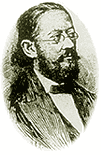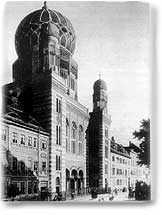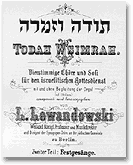September 2000 Elul 5760

|
|
This month is ELUL General Bak Samuel Archive MUSIC Voice of the Turtle Archive BOOKSHELF Book of Values Archive DAY-BY-DAY Ethical lesson PERSONALITIES Else Lasker-Schüler Archive WEEKLY TORAH PORTION FREE GREETING CARDS SEARCH THE SITE: GO |
 |
|
In the year 1840 in the city of Berlin, the first choir director in the history of the synagogue was appointed. At the Heiderautergasse Temple, and later at the new Oranienburgerstrasse Temple, Louis Lewandowski (1821-1894) conducted the music of his Viennese mentor, the great Cantor Salomon Sulzer, as well as his own compositions. The music of German synagogues had for centuries consisted of cantorial recitatives and congregational responses, and Lewandowski's choral compositions introduced a new and popular type of service.
For twenty-four years Lewandowski worked as choirmaster at the Heidereutergasse Temple in Berlin, conducting the music of Salomon Sulzer. But in 1864 the building of the Oranienburgerstrasse Temple, which was equipped with an organ, offered Lewandowski the opportunity of creating an entire new service with organ accompaniment — a task never before undertaken. The culmination of his career came in 1882 with the publication of his magnum opus, Todah ve-Zimrah (Thanks and Song), a setting of the entire liturgical cycle for four soloists, cantor and organ. Lewandowski was among the most significant composers of synagogue music, reproducing the traditional melodies in a more classical form and giving freer treatment to the organ music than his distinguished predecessor Cantor Sulzer had. He exerted a strong influence on Western Ashkenazi synagogal music through his activities as a teacher at the Jewish Free School and the Jewish Teachers' Seminary in Berlin. He based his compositions on the liturgical tradition of the Old Synagogue, on the one hand, and on the East European tunes he received from immigrant cantors, on the other. His choral settings following the style of Mendelssohn's oratorios and works for choir. Among Lewandowski's principal works are Kol Rina u-Tfillah (1871), Todah ve-Zimrah for four soloists, cantor and organ (1876-1882), and 18 liturgical Psalms for solo, choir and organ.
|
About JHOM.com || MAXIMA Multimedia || Memorial Foundation || Contact Us || Privacy Policy || Copyrights || Printable Format

 Louis
Lewandowski was born in the Polish town of Wreschen. At the age of twelve,
after his mother's death and because of his family's extreme poverty,
he left for Berlin here he became an apprentice for cantor Asher Lion.
Soon the boy's musical ambition reached out beyond the ghetto. With
the help of Alexander Mendelssohn (cousin of the composer Felix Mendelssohn),
Lewandowski became the first Jew to attend the Berlin Academy of the
Arts. But after showing great promise in the field of secular music
(including a prize for composition from the prestigious Berlin Singakademie),
Lewandowski succumbed to a serious nervous disorder and was forced to
relinquish his scholarship and abandon his studies. It was after his
partial recovery that the lad decided to devote himself fully to the
music of the synagogue.
Louis
Lewandowski was born in the Polish town of Wreschen. At the age of twelve,
after his mother's death and because of his family's extreme poverty,
he left for Berlin here he became an apprentice for cantor Asher Lion.
Soon the boy's musical ambition reached out beyond the ghetto. With
the help of Alexander Mendelssohn (cousin of the composer Felix Mendelssohn),
Lewandowski became the first Jew to attend the Berlin Academy of the
Arts. But after showing great promise in the field of secular music
(including a prize for composition from the prestigious Berlin Singakademie),
Lewandowski succumbed to a serious nervous disorder and was forced to
relinquish his scholarship and abandon his studies. It was after his
partial recovery that the lad decided to devote himself fully to the
music of the synagogue.
